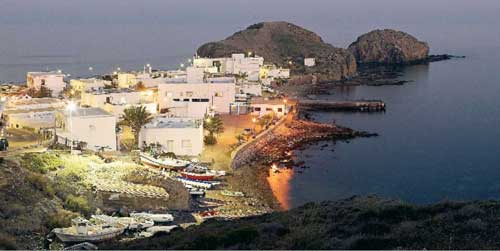The lands of the Cabo de Gata Almeria were formed by the last volcanic eruption that took place in the Iberian Peninsula. The magma, the sea, …
Almeria’s Cabo de Gata Natural Park was formed when a last volcanic eruption shook the Iberian peninsula. Magma, sea, desert and the action of time have managed to model a spectacular landscape that will not leave anyone indifferent.
A landscape midway between the Arizona desert and the moon. That’s what the visitor finds when he or she arrives to Cabo de Gata. The black volcanic hills eroded by the centuries will seem familiar from the movies. And yet, while admiring such surprising conformations, our nose will soon recognize the smell of salt. From any vantage point, the waves becomes a visible presence, and their scent permeates even the most minuscule grain of black sand in this desert which smells of the sea. Upon arrival, the first trait to catch the eye may be the strong.
colours of these lands. The palette of colours ranges from the blackest of blacks from the millenial volcanic cones to the white of the sand in some of the beaches, while covering the yellows and ochres of its valleys. This tiny area in eastern Andalusia, surrounded by the sea of plastic covers peculiar to the intensive agriculture of nearby El Ejido and by urban development elsewhere, resists as one of the best conserved enclaves in the Mediterranean coast. The perpetual drought that afflicts this harsh soil confers a flora that is closer to northern Africa than to the rest of the Iberian peninsula. Over the cliffs, fishing eagles and Audouin’s gulls majestically fly in the blue skies. Tiny fishing villages where the houses are built just next to the shore are still to be found in this area. The beaches are dotted with small business opened by the first foreign travellers who chose to stay in the area. In San Pedro or Aguamarga, black-clad old ladies mix with a small neo-hippy community which has at last found its promised land.

THE ROAD TO PARADISE
San José is the neuralgic centre of Cabo de Gata. The brand-new aparment blocks and hotels offer a stark contrast with the houses with white walls and blue windows typical of the fishing villages in the area. From San José we’ll be able to reach two of the very last paradise spots In the Mediterranean: the Mónsul and Los Genoveses beaches. The Los Genoveses inlet may look familiar, and no wonder: sequences from Lawrence of Arabia and the Indiana Jones movies were filmed in it. In the beach at Los Escullos, erosion from the wind has sculpted spectral profiles in the rocks. This spot is also known for the ancient fortress that dominates the landscape: the San Felipe castle. Only two kilometres away, La Isleta del Moro is a wonderful fishing village attached to a dark volcanic isle entering the sea. Following the road to the interior, we’ll arrive to the old mining town of Rodalquilar, whose atmosphere seems somehow similar to that of an old town from the American West: the gold mines were actually in operation up until the 1960’s. Today, many artists find their inspiration in the light and the landscapes of the town, which offers a peculiar bohemian air.
Close to Rodalquilar, the beautiful village of Las Negras owes its name to a curious story: after all the fishermen from the San Pedro cove died at sea, the women in the village all become widowed. The mourning dresses they subsequently adopted with time gave name to the spot: Las Negras, or, “The Black Ladies.” Today, Las Negras is home to a scubadiving school for those interested in enjoying the splendid rocky conformations under the clear sea waters. In Monsul we are even able to see such beauty at a depth of just one metre!… And yet, it’s between five and 20 metres where expert divers in the know choose to admire a truly submarine wonder: the plains of posidonia in all their splendour.
Finally, in the meridional limit of the Natural Park, we’ll find the Cabo de Gata lighthouse. The most south-western spot in Spain, that was built in 1861 over the ruins of the San Francisco de Paula castle. During decades, it guided the boats leaving the Mediterranean for the straits of Gibraltar. At dusk, when the air smells of salt, from the lighthouse we can enjoy a splendid sunset slowly illuminating the La Fabriquilla salines, where flamingos rest.

